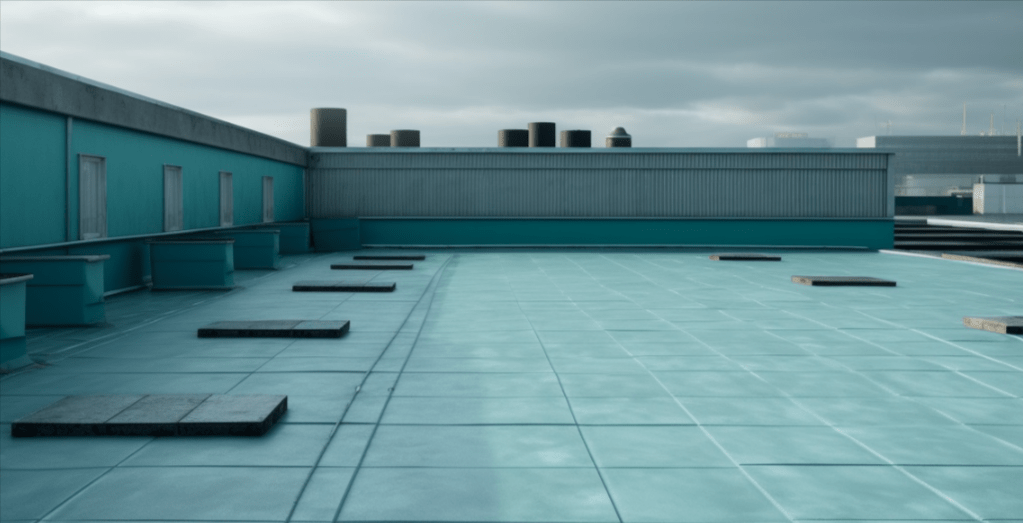Roofing is a critical component of any commercial real estate (CRE) project, and choosing the right type of roof can significantly impact the building’s overall performance, energy efficiency, and durability. In this article, we’ll explore the different types of roofing systems available for CRE and how they can benefit your building.
Flat Roofing Systems
Flat roofs are prevalent in commercial buildings due to their space efficiency, ease of installation, and accessibility for maintenance. There are several types of flat roofing systems, each with its advantages and disadvantages:
- Thermoplastic Olefin (TPO): TPO is a single-ply roofing membrane known for its durability, energy efficiency, and ease of installation. It reflects sunlight, reducing the building’s cooling costs, and is resistant to chemicals and punctures. However, TPO can have a shorter lifespan compared to other materials, with an average of 15-20 years. Learn more about TPO roofing here.
- Ethylene Propylene Diene Monomer (EPDM): EPDM is a synthetic rubber material that offers excellent resistance to weathering, UV rays, and ozone. It is lightweight, making it suitable for buildings with less structural support. EPDM roofs can last up to 30 years with proper maintenance.
- Polyvinyl Chloride (PVC): PVC roofing is known for its longevity, with a lifespan of up to 30 years. It is highly resistant to chemicals, making it an ideal choice for buildings exposed to chemical fumes or grease, such as restaurants or manufacturing facilities. However, PVC roofing can be more expensive than TPO or EPDM.
Sloped Roofing Systems
Sloped roofs are less common in commercial real estate but offer advantages like improved drainage and aesthetic appeal. Some popular sloped roofing materials include:
- Metal: Metal roofing is highly durable, energy-efficient, and low-maintenance. It can last up to 50 years or more with proper care. Metal roofs are available in a variety of materials, including steel, aluminum, copper, and zinc, each with its characteristics and price points. They are also lightweight and can be installed over existing roofing materials in some cases.
- Asphalt Shingles: Asphalt shingles are an affordable option for sloped commercial roofs, offering a balance of cost and durability. They come in various styles and colors, allowing for customization to match the building’s aesthetic. The average lifespan of asphalt shingles is 15-30 years. However, they may not be suitable for regions with extreme temperatures or high winds.
- Tile: Tile roofing is a long-lasting and visually appealing option for commercial buildings. Common materials include clay, concrete, and slate, each with its benefits and drawbacks. Tile roofing is highly resistant to fire and pests and can last up to 100 years with proper care.
Green Roofing Systems
Green roofs are an eco-friendly option that incorporates vegetation to provide environmental and energy-saving benefits. There are three main types of green roofs:
- Intensive Green Roofs: Intensive green roofs, also known as rooftop gardens, use deeper soil layers to support a broader range of plant life, including trees, shrubs, and perennials. These roofs can serve as recreational spaces and provide better insulation and stormwater management than extensive green roofs. However, they are heavier and require more maintenance, including irrigation and regular pruning.
- Semi-Intensive Green Roofs: Semi-intensive green roofs offer a compromise between extensive and intensive systems, with a moderate soil depth supporting a mix of low-maintenance and more diverse plant species. These roofs provide a balance of insulation, stormwater management, and aesthetic appeal, but may require more maintenance than extensive green roofs.
- Extensive Green Roofs: Extensive green roofs are lightweight, low-maintenance systems that use a shallow layer of soil and hardy plants like sedum, mosses, and grasses. They are suitable for buildings with limited structural support and provide insulation, stormwater management, and improved air quality. However, they may not be as visually appealing as other green roof types.
Roofing System Selection
When selecting a roofing system for your commercial real estate project, consider the following factors:
- Climate: The local climate plays a significant role in determining the most suitable roofing material. For example, in areas with heavy snow or rain, sloped roofs may be preferable, while flat roofs with a reflective membrane like TPO can be more efficient in hot climates.
- Building Use: Consider the building’s purpose and the potential impact on the roofing system. For instance, if your building houses a restaurant, a PVC roof may be a better choice due to its resistance to grease and chemicals.
- Maintenance Requirements: Different roofing systems have varying maintenance needs. Green roofs, particularly intensive ones, require more upkeep than traditional flat or sloped roofs. Factor in the long-term maintenance costs when making your decision.
- Budget: The initial cost of the roofing system is an essential consideration, but don’t forget to factor in long-term costs like maintenance and potential energy savings.
It’s crucial to research and consult with professionals to ensure you make the best decision for your specific project.
Conclusion
We’ve explored flat, sloped, and green roofing systems in this article, each with its unique benefits and considerations. The right choice for your commercial real estate project will depend on factors like climate, building use, and budget. Remember that it’s essential to research thoroughly and consult with professionals to make the most informed decision possible. With the right information, you can confidently select a roofing system that will serve your building well for years to come.
Frequently Asked Questions (FAQs)
To help you further understand commercial real estate roofing, here are some common questions and answers:
Q: How long do commercial roofing systems typically last?
A: The lifespan of a commercial roof can vary greatly depending on the material, installation quality, and maintenance. Generally, flat roofing materials like TPO, EPDM, and PVC can last 15-30 years, while sloped roofing materials like metal and tiles can last 40-70 years. Green roofs can also have long lifespans, but the longevity will depend on factors like the type of vegetation and maintenance practices.
Q: How much does it cost to install a commercial roof?
A: The cost of installing a commercial roof depends on factors such as the type of roofing system, the size of the roof, and the materials used. Generally, flat roofing systems tend to be more affordable than sloped systems, but the specific costs will vary. Consult with professional roofing contractors to get accurate estimates for your project.

